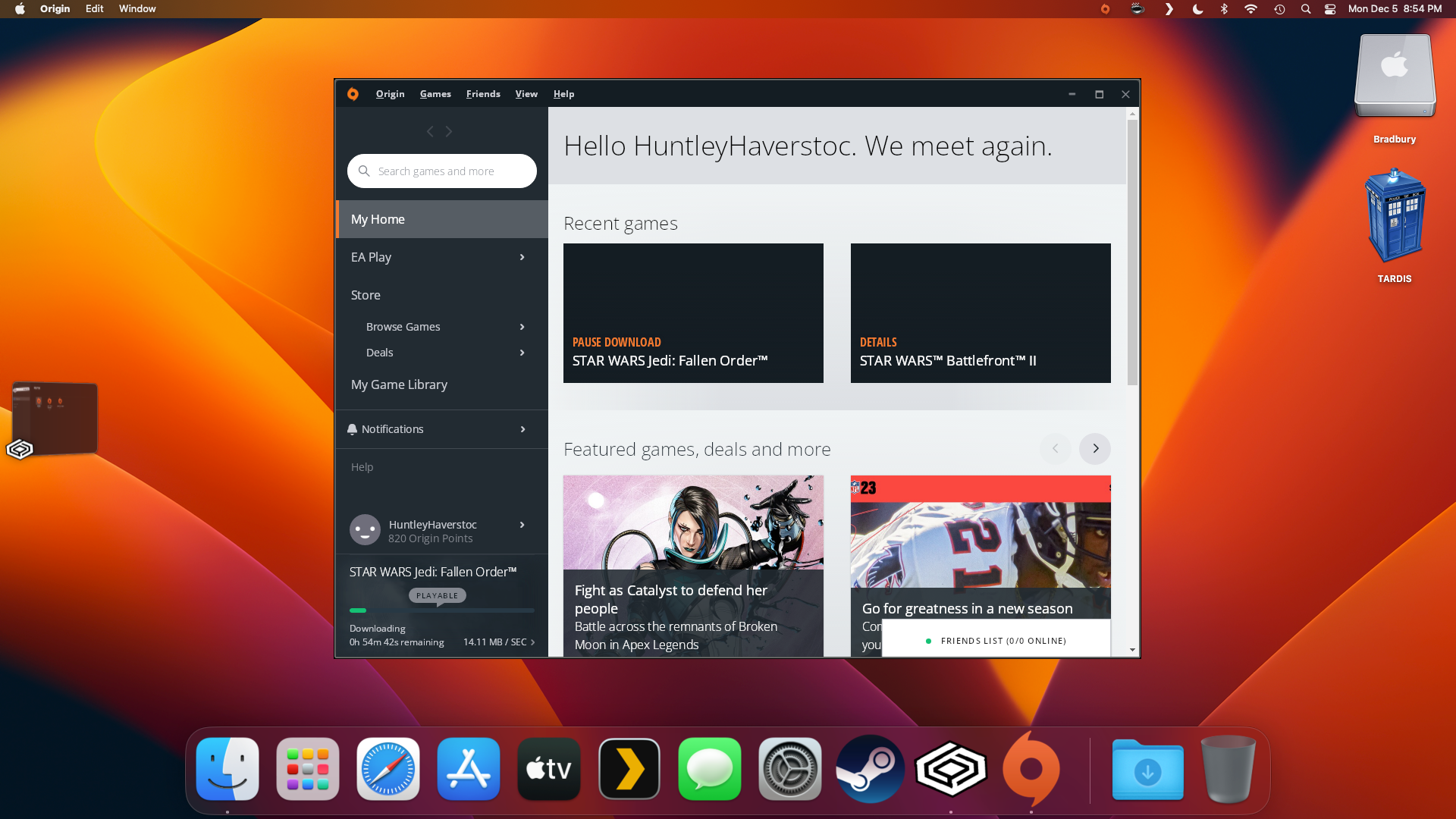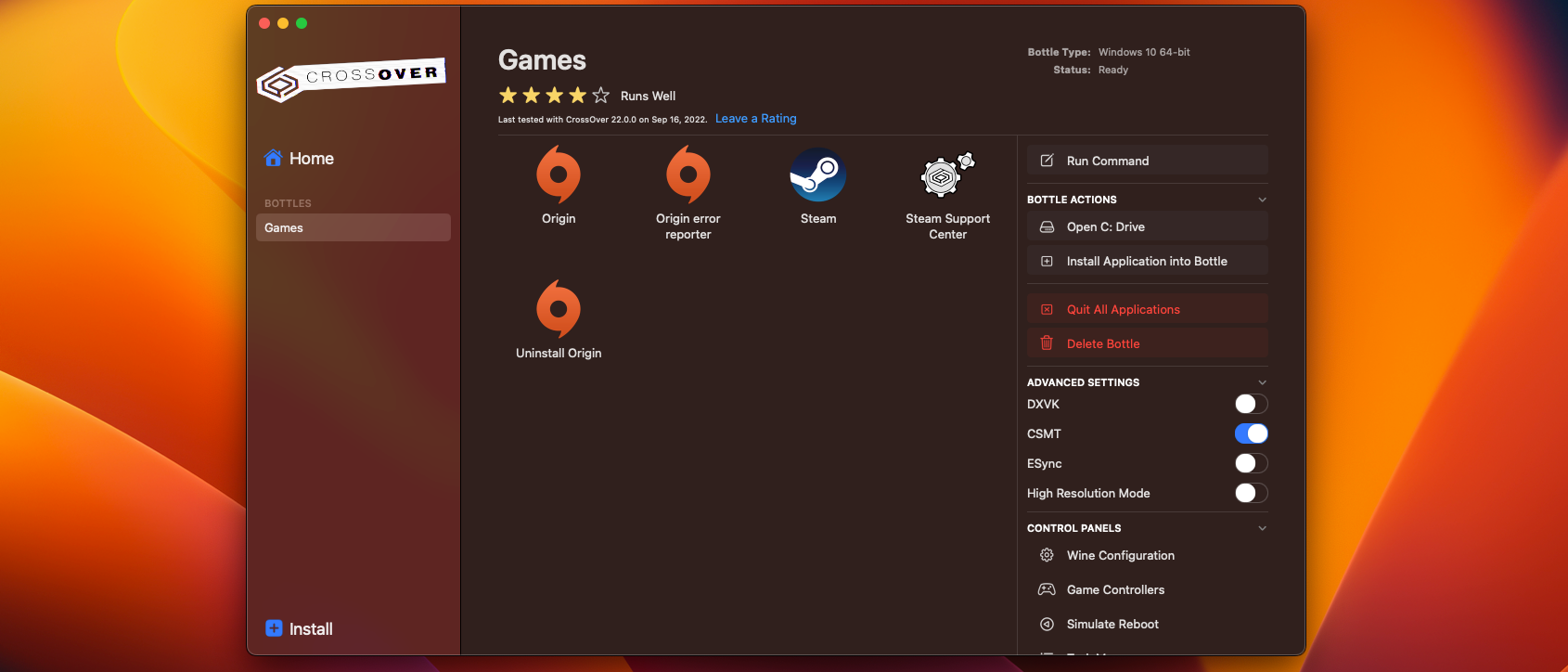iMore Verdict
Dedicated gamers will likely want their own separate PC, or at least a virtual machine. But for people who just want to play occasional or specific PC titles on their Mac without buying a copy of Windows, and don’t mind the possibility of jankiness along the way, CrossOver makes for a fun experiment.
Pros
- +
Lightweight solution to running PC apps on Mac
- +
Easy to install and use
- +
14-day try-before-you-buy period
- +
No need to buy a copy of Windows
Cons
- -
Requires a fast processor and lots of memory
- -
Can't work with some forms of PC software
- -
Titles may run incompletely, or not at all
You can always trust iMore.
There will always be apps — mostly games — whose publishers won’t port them to the Mac for financial or contractual reasons. Codeweavers’ CrossOver offers a simple, convenient way to run many of those apps. The result isn’t as reliable or universal as other solutions, but it’s a lot cheaper and easier, and with CrossOver’s helpful database of app functionality and generous try-before-you-buy period, you can see whether it’ll run the apps you want to use before you commit your hard-earned cash.
CrossOver translates Windows commands into Mac ones on the fly — like hiring an interpreter to help you in a foreign country, rather than learning the language yourself. It’s based on the open-source WINE project, but its improvements to standard WINE make it a lot easier for everyday users to successfully run.
| CrossOver Mac 22.0 | Header Cell - Column 1 |
|---|---|
| Developer | Codeweavers |
| Minimum Requirements | macOS 10.13 or higher (Intel), macOS 11.1 or higher (Apple Silicon), 1GB of free disk space plus more for installed Windows applications |
| Price | $74 for one year of updates; $494 for lifetime updates |
Price and availability
CrossOver 22 is only available from Codeweavers' web site. $74 gets you a full copy and a year’s worth of updates to the app. Once that period elapses, you can still use the copy you already have as long as you want to, but you won’t be able to download fresh updates. You'll have a limited window of time after your subscription expires to renew it for roughly $30.
You can also pay $494 for CrossOver Life, which removes the need for annual renewals. The company tends to offer once-a-year discounts around Black Friday, sometimes slashing the cost of a year's updates to as little as $15.
What I like about CrossOver 22

After a quick installation, CrossOver does most of the hard work for you. It sets up a “bottle” — a contained virtual environment — in which you can install basic Windows or Linux underpinnings, plus any apps you’d care to run. CrossOver builds in shortcuts to install popular apps like Steam, and it can seamlessly install apps from the Internet, from downloaded ISO files, or from a physical disc, should you have an external drive.
You can have multiple separate bottles for different apps, or put all the apps you use in a single vessel. As with containerized software setups like Docker, this makes CrossOver easier and less stressful to use. In the unlikely event that something goes horribly wrong inside a bottle, it won’t affect your larger system. You can just delete the bottle and start fresh.
CrossOver 22’s biggest leap forward lies in its overhauled interface.
Each new version of CrossOver offers under-the-hood improvements to help all apps in general and specific titles in particular run better. But CrossOver 22’s biggest leap forward lies in its overhauled interface.
Previous versions hid important toggles and features behind poorly designed contextual menus. CrossOver 22 takes its design cues instead from the Mac App Store, putting crucial options in full view. It’s easier than ever to run apps you’ve already installed, or add new ones.
Codeweavers’ database of popular apps and their compatibility, maintained by volunteer testers, is now more directly integrated into the app itself, rather than requiring a separate visit to Codeweavers's web site. That database isn’t comprehensive — some titles I’ve personally used under CrossOver aren’t included — but it’s a good place to start when you’re curious about whether a particular app will run there.
What I don't like about CrossOver 22
The path between original Windows code and successful Mac execution isn’t always straight. For instance, Windows games use a set of tools known as DirectX to enable 3D graphics. CrossOver has to pass those commands through an open-source translator called DXVK, which maps them to the open-source Vulkan 3D standard. These Vulkan commands must then go through another interpreter, MoltenVK, to run under Apple’s own 3D toolkit, Metal. Each of these handoffs eats up processing power and makes the resulting games run slower and less reliably than they would if coded for the Mac from the get-go.
The beefier your processing power, the better performance you’ll get from CrossOver. Even though it’s an Intel native app, it runs best on Apple silicon under Rosetta 2 emulation, thanks to the sheer horsepower of the M1 and higher. (CrossOver plans to eventually support Apple silicon, but Codeweavers says that transition is likely years away.) Popular launcher apps like Steam, and simpler 2D games like Guacamelee, ran without a hitch in my tests, but more sophisticated titles had various degrees of tradeoffs.
If you want to game with CrossOver, having more than 8GB RAM or something more powerful than a basic M1 will likely serve you well.
When I ran 2017’s Star Wars: Battlefront II on my stock M1 Mac Mini, the game looked great. But depending on the game mode and the size and type of the environments I found myself in, performance ranged from fast and fluid to an unplayable crawl. I’ve seen YouTube videos of other CrossOver users playing the game much more smoothly, even on levels that choked my computer. If you want to game with CrossOver, having more than 8GB RAM or something more powerful than a basic M1 will likely serve you well.
Furthermore, Metal has different aims and priorities than DirectX, trading some measure of tech sophistication for the ability to run across MacOS, iOS, and tvOS. Even under Apple’s recently announced Metal 3, there are just some things DirectX does for which Metal lacks an easily translated equivalent.
Though the game mostly ran smoothly barring some pauses for loading, the world around my protagonist rendered as a mass of flickering black triangles.
I saw this firsthand playing Jedi: Fallen Order. Though the game mostly ran smoothly barring some pauses for loading, the world around my protagonist didn’t render right, presenting a mass of flickering black triangles instead of realistic surroundings. I was able to adapt and still enjoy the game, but if you’re looking for absolute fidelity, consider this fair warning.
And even if everything else goes swimmingly, there are some facets of Windows software that just won’t work outside that platform, no matter what. Barring some miracle in a future version, I’ll never know how well Star Wars: Squadrons runs on CrossOver, because the anti-cheating software for its multiplayer mode won’t cooperate, shutting down every attempt to install the game.
CrossOver 22: Competitors
Intel Macs can directly install Windows through Boot Camp, but this option isn't available on newer Apple Silicon-powered Macs.
Virtual machines like VMWare Fusion and Parallels Desktop let Mac users run Windows and its apps. By emulating the entire Windows operating system, they offer better compatibility with more kinds of PC apps, especially games.
Both apps are Apple Silicon native and can, with various degrees of workarounds, run Apple Silicon-friendly ARM-based versions of Windows 11 (and their apps) natively. CrossOver tops out at apps for Windows 10, and because of the engineering complexities involved, Codeweavers says it won't offer a native Apple Silicon version for several more years.
But Parallels and VMWare each cost more than a year of CrossOver updates, and neither will work without a copy of Windows itself. Even an older version of that can run you as much as $140.
CrossOver 22: Should You Buy?
You should buy this if:
- You need a lightweight, inexpensive, easy way to run Windows apps on your Mac
- You've tested the apps you want to run to make sure they work with CrossOver
- You don't want to buy and install a copy of Windows
You shouldn't buy this if:
- You need to run Windows itself on your Mac
- You need to run a lot of different Windows apps
- You need every Windows app you run to work well, if not perfectly, on the Mac
Verdict
CrossOver 22 is impressive in its simplicity — at least in terms of how easy it is to get select Windows applications up and running on macOS. It's by no means perfect, and your mileage will vary dramatically depending on the complexity of the applications you're looking to run, not to mention the power of your Mac computer itself. But with prudent use of the free trial to test your must-work apps, it's a great opportunity to bridge the gap between Apple and Microsoft's computing worlds.

For
- Lightweight solution to running PC apps on Mac
- Easy to install and use
- 14-day try-before-you-buy period
- No need to buy a copy of Windows
Against
- Requires a fast processor and lots of memory of run hardware-intensive titles well
- Can't work with some forms of PC software
- Titles may run incompletely, or not at all

Nathan Alderman is an iMore contributor. He’s been using Apple computers since his first Apple IIe in 1985, and writing professionally about Macs and their software since 2005. During his 12 years freelancing for Macworld, he covered email clients, web browsers, web design programs, writing apps, and games, and he’s continued to follow those interests at iMore since 2017. An editor and writing coach in his full-time career, he spends his dwindling spare time writing fiction for fun, volunteering for democracy, and contributing to podcasts on The Incomparable Network. Nathan adores his wife and wrangles his alarmingly large children in bucolic Crozet, VA.
